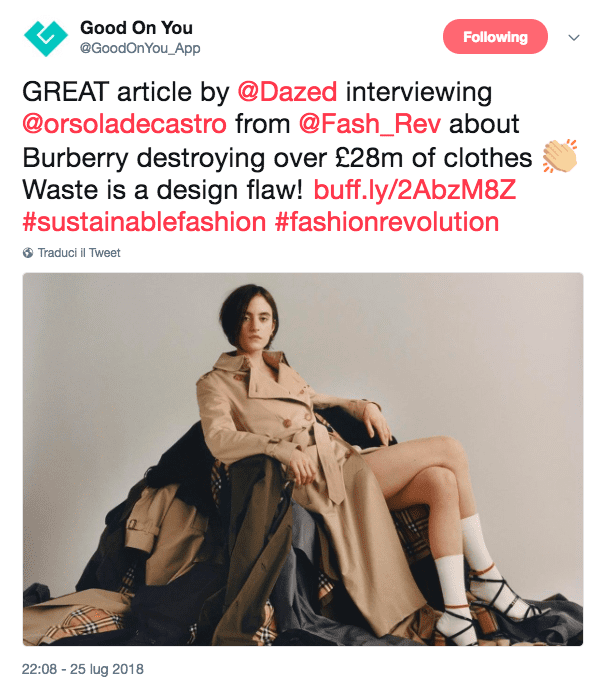At the end of the last April in the post dedicated to ‘Loved Clothes Last’, the # 2 fanzine of Fashion Revolution, I talked, among other things, about the different destinies unsold clothing got and the most brutal was to go straight into the incinerator. Imagine that sadness and what a waste! Kilometers of fabric, perhaps precious if it is high-end clothes, along with all kinds of decorations, from buttons to zippers to applications, not to mention the hours of work of tailors and / or workers who have assembled, sewn, dyed , etc., all burned, like this.
In this regard it’s a few days ago the news, really baffling, that last year the iconic British brand Burberry has destroyed something like £28m of clothes and perfume. £28 million! Little wonder, because for brands, and here we also talk about luxury brands, this is a usual practice and the English magazine ‘Dazed and Confused’, in an article of 25 July, explains the reasons: there’s the fact, for example, that it is preferable to destroy the products rather than reduce them a lot to preserve the exclusive image of a particular brand. “If the market becomes oversaturated with cut-price products, it can negatively impact a label’s prestige – brands need their high prices to seem justifiable, and exclusivity is a key part of that”. Then there is the argument of the counterfeiting; if a sufficient quantity of items were sold at a fairly low price, it could end up in the wrong hands fueling a market worth $450bn.

Orsola De Castro, eco-designer and co-founder of Fashion Revolution, spoke on the subject; first of all, “there is no such thing as an environmentally friendly way of burning clothes” and part of this is to do with the materials: “many of these (pieces of) clothing contain components such as synthetic linings or zips and buttons that are plastic. You can burn plastic, but it doesn’t become ash”. This as regards only the incineration phase. Then there is everything else. “The practice of destroying the unsold” continues De Castro “is a direct consequence of mass production, not just Burberry but also many other luxury brands do the same. We produce a staggering 100 to 150 billion items of clothing each year and as a direct result, we’re seeing huge amounts of surplus throughout the fashion supply chain. We need to tackle this problem at source; we need greater transparency throughout the fashion supply chain because it is precisely the lack of transparency that prevents to understand exactly how much waste and surplus are created, where they are produced, how they are disposed of and the impact they have on the environment”.
Orsola De Castro then says that Burberry interestingly score reasonably well in the Fashion Transparency Index and champion lots of good sustainability initiatives. But here it’s a whole system that needs to invest more in efficiency, in alternative solutions: “more energy should be spent on creative interim solutions such as upcycling and a cultural shift from mass production and mass consumption to a more moderate production leading to mindful consumption, better care and a less throwaway approach from brands and consumers alike. Improving the way we buy, care and dispose of our clothes is everyone’s responsibility, and it requires a change in our own personal shopping habits. But our local governments and fashion brands have a responsibility too and we can encourage them to do more”.
We have said that so many times here on eco-à-porter and we will not stop saying it again: greater responsibility on all sides.
















